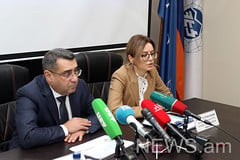
NEWS.am presents the exclusive interview with EU Special Representative for the South Caucasus.
Is it clear where specifically in the territory of Armenia the EU Monitoring mission will be deployed? What kind of work will be conducted within the framework of the mission?
These parameters, including specific organizational and operational issues, are currently being finalized in the framework of the ongoing work and consultations carried out by the EU Technical Assessment Mission, which was deployed to Armenia on 14 October. It is foreseen that the future EU Monitoring Capacity in Armenia will be composed of a total of about 40 monitors. Their primary task will be to monitor the situation on the ground through road patrols in areas of interest on the Armenian side of the Armenia-Azerbaijan border. Based on their observations, reports will be submitted to the HQ in Brussels on a regular basis.
Azerbaijani armed forces continue to violate the ceasefire along the border with Armenia trying also to attribute the responsibility to the Armenian side. As the Prime Minister of Armenia stressed, Azerbaijan is seeking to create a pretext for a new military aggression against Armenia. Will the EU Monitoring mission have any functions and leverages to prevent new escalations like the one that took place in the middle of September because of the Azerbaijani intervention into the territory of Armenia?
As I just said, the EU Monitoring Capacity has a clear mandate to report back to Brussels HQ on any security-related developments on the ground. Based on discussions with the leaderships of both countries, we expect the sides to cooperate with the EU monitors and contribute to a stabilization of the situation, thus allowing for an environment conducive to peace talks and focused work of the border commissions. The expectation is that the presence of the EU monitors will help deter any further escalation.
The President of Azerbaijan announced that he had declined the possibility of deploying EU mission in the territory of Azerbaijan. According to the statement released in the result of the Prague meeting, Azerbaijan has agreed to cooperate with this mission “as far as it is concerned”. Doesn’t the Azerbaijani declination regarding the deployment of the EU mission also from the Azerbaijani side restrict the possible effectiveness of the mission?
The Azerbaijani side has committed to engaging with the mission through regular contacts between relevant actors on the ground, even without a physical presence on the Azerbaijani side of the Armenian-Azerbaijani state border. Indeed, as a result of the Prague meeting on 6 October, there was an agreement by Armenia to facilitate a civilian EU mission alongside the border with Azerbaijan and the latter agreed to cooperate with this mission as far as it is concerned. The deployment of the EU Monitoring Capacity in Armenia also follows a specific request made by Armenia through an official letter sent by the Armenian Foreign Minister to HR/VP J. Borrell on 22 September.
An agreement was reached in Prague that the UN Charter and Alma Ata 1991 Declaration would lie in the basis for the work of the border delimitation commissions and that the next meeting of the border commissions would take place in Brussels by the end of October. Meanwhile, the sovereign territories of Armenia have not yet been deoccupied by the Azerbaijani armed forces, and there is still no agreement about the withdrawal of Azerbaijani forces from these territories. What perspective does the delimitation process have given the fact that the Armenian territories are still occupied?
When HR/VP Borrell spoke in front of the European Parliament some weeks ago, he made clear that Azerbaijani forces should be withdrawn to their side of the mutual border. That border exists, even though it is not demarcated. Also Armenian forces that are on the Azerbaijani side of the bilateral border should be pulled back. Reducing tensions in this way would surely contribute positively to the work of the delimitation commissions. To my mind both are essential: respect for the existing border and full engagement in the delimitation talks. It is our hope that the next meeting of the border commissions in Brussels will help achieve some concrete results.
Armenia and Azerbaijan are announcing about various maps of different times to lie in the basis of delimitation of Armenia-Azerbaijan border. What’s EU position on this - what kind of maps should be the basis for delimitation in order to reach balanced decisions?
One of the main outcomes of the Prague meeting on 6 October was Armenia and Azerbaijan confirming their commitment to the Charter of the United Nations and the Alma Ata 1991 Declaration through which both recognized each other’s territorial integrity and sovereignty. They confirmed it would be a basis for the work of the border delimitation commissions. The EU believes that this reference to the Alma Ata 1991 Declaration speaks clearly about the need to ensure respect for borders as they existed during the latest agreed arrangements to date, i.e. the administrative borders of the Armenian Soviet Socialist Republic and the Azerbaijan Soviet Socialist Republic. For lack of any other line, it would be important for the sides to at least agree on this as a starting point for their negotiations.
There is no mention about the Nagorno-Karabakh conflict, the core rights of the people of Nagorno-Karabakh in the statement of the Prague meeting. What’s EU position on the future of Nagorno-Karabakh and its people which are permanently under the existential threat by Azerbaijan?
We all know how the conflict started and we also hear the concerns voiced by the Armenian side. The future of the Armenian population of Karabakh needs to be addressed seriously and we have been exchanging views on the matter on a regular basis with our interlocutors in Azerbaijan and in Armenia. It is of utmost importance that the security situation around Karabakh remains stable and for an atmosphere of trust to emerge, so that the people on the ground can envisage a peaceful future allowing for practical solutions to be found through active negotiations between both sides, and ultimately for a process of reconciliation to start. The EU, including at the highest level, has always made it very clear that guarantees for the rights and security of the Armenian population of Karabakh will be a key element of a future peaceful South Caucasus.
What is the EU position, should the issue of Nagorno-Karabakh be a part of the possible peace treaty between Armenia and Azerbaijan?
We have heard the position of the Armenian authorities on the matter recently about the need to address issues relating to Karabakh separately from the Armenia-Azerbaijan normalization track. We also hear the statements from Baku on the matter. I above all believe that it is essential for Baku to elaborate a comprehensive strategy and engage in a constructive and transparent process of dialogue with the Armenian population in Karabakh, which is supported by the international community. A solution that will ensure Karabakh Armenians’ rights and security is in the interest of the population on the ground, it is in the interest of Armenia, it is in the interest of Azerbaijan and it is also in the interest of the international community.
There are official statements both by Yerevan and Baku about the possibility of signing the peace treaty till the end of this year. Do you consider this perspective realistic?
We have also heard these statements. The sides have publicly and repeatedly commented on the principles that should be part of such a future peace treaty. We are encouraged by the meetings held between the Foreign Ministers. Whether the aim of the end of the year is achieved will depend on the sides. What is clear is that we support this process and are convinced that an agreement will be a crucial element for a comprehensive settlement of the conflict.
Your statement on videos “showing war crimes committed against Azerbaijanis, which need to be investigated and if authentic, perpetrators need to be held responsible,” was widely criticized in Armenian social media. After your statement another video of torturing Armenian soldiers by the Azerbaijanis was published. As it is known, they were also killed in captivity. How would you comment on the latest video?
Numerous horrific videos have been published over the past weeks showing unacceptable violence against prisoners and other human rights violations which, if proven authentic, would amount to war crimes. I have clearly stated that past crimes can in no way justify a repetition of violence. This has to stop once and for all, and the perpetrators of these crimes must face justice. There is also a need to acknowledge and investigate earlier crimes, regardless of who committed them. However, we expect the authorities to very clearly state their unequivocal condemnation of these awful acts, and to guarantee full-fledged investigations and prosecution of perpetrators. The Azerbaijani authorities have taken initial steps to investigate the latest reports of violence and we will closely follow these proceedings. At the same time, I would like to reiterate our call on both sides on the need to ensure a fair treatment of past and recent violence, but also to do everything in their power to avoid a repetition of such indescribable acts. The page of enmity and hatred needs to be turned once and for all, for the benefit of future generations.
Hayk Sahakyan
















